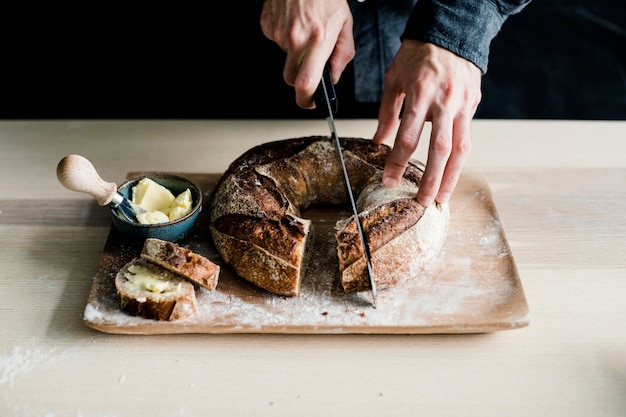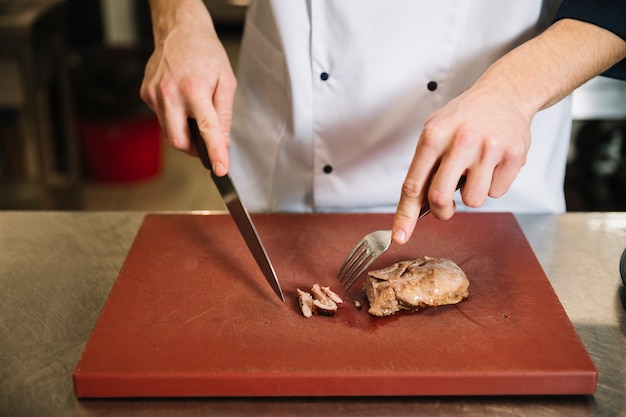(Part 1) Choosing the Right Cut: The Foundation of Your Masterpiece

Understanding the Beef Grading System: A Guide to Quality
And while we're on the subject of choosing the right cut, let's talk about grading. It's like choosing the perfect bottle of wine, you know? You have different grades like Select, Choice, and Prime, each with its own level of marbling and flavour. Prime is the highest grade, offering the richest flavour and tenderness, thanks to that beautiful marbling. But let's be honest, if you're on a budget, Choice is a fantastic option, especially if you're cooking with a bit of fat like butter or oil. You'll still get a steak that's absolutely delicious!Choosing the Right Cut Based on Your Preferences
Now, when it comes to the cut itself, you've got some options! A "center-cut" fillet mignon is the most tender, as it comes from the middle of the tenderloin. You can also find "tail-end" or "butt-end" pieces, which are a little less expensive but still delicious. Just remember that they might be a bit tougher than the center-cut.(Part 2) Seasoning Up Your Masterpiece: Enhancing the Natural Flavour

Keeping it Simple and Delicious: The Power of Salt and Pepper
For me, simple is always best. Salt and pepper are all you really need to bring out the natural flavour of the beef. But, if you want to add a little extra zing, try a pinch of garlic powder or onion powder. You can also get fancy with a sprinkle of dried herbs like thyme or rosemary. Just remember, don't go overboard! You want to enhance the natural flavour of the beef, not mask it with a whole bunch of spices.A Word of Caution: Timing is Everything
The key here is to season your fillet mignon just before cooking. This allows the salt to draw out the moisture and create a beautiful crust. If you season it too early, the salt will start to dehydrate the meat, leading to a less tender and flavorful result.(Part 3) Getting Ready to Cook: The First Steps to Success

Preheat Your Oven: The Key to Even Cooking
The first thing you want to do is preheat your oven to 400°F (200°C). This is crucial because you want the oven to be nice and hot when the fillet mignon goes in. Trust me, you'll get a much better sear that way. And speaking of sear, let's talk about that next.(Part 4) Achieving that Perfect Sear: The Secret to a Crispy, Flavorful Crust
Searing is essential for achieving a beautiful, crispy crust on your fillet mignon. It also helps lock in the juices, so you get a tender, flavourful result.Using a cast iron pan: The Best Tool for the Job
I love to use a cast iron pan for searing because it heats up evenly and retains heat really well. Get your pan nice and hot over medium-high heat and add a tablespoon of oil or butter. You know the pan is hot enough when the oil starts to shimmer. Now, carefully place your fillet mignon in the pan and let it cook for about 3-4 minutes on each side. Don't move it around too much; you want to let it develop a nice brown crust.Adding a Touch of Butter: The Final Touch of Richness
Just before you take the fillet mignon out of the pan, add a knob of butter and let it melt. As it melts, spoon the butter over the top of the steak. It'll create an incredibly rich and flavorful crust, adding another layer of deliciousness to your masterpiece.(Part 5) Finishing in the Oven: Ensuring Even Cooking and Tenderness
Your fillet mignon is now beautifully seared and ready for the oven. Now, it's time to transfer it to a baking sheet and pop it in the oven.cooking time Depends on Your Desired Doneness: A Guide for Every Taste
The cooking time depends on how you like your steak. Here's a guide:- Rare: 3-4 minutes per side in the oven
- Medium-rare: 5-6 minutes per side in the oven
- Medium: 7-8 minutes per side in the oven
- Medium-well: 9-10 minutes per side in the oven
- Well-done: 11-12 minutes per side in the oven
Remember, these are just guidelines. You can always use a meat thermometer to check the internal temperature. Here's a handy table:
| Doneness | Internal Temperature (°F) |
|---|---|
| Rare | 125-130 |
| Medium-rare | 130-135 |
| Medium | 140-145 |
| Medium-well | 150-155 |
| Well-done | 160 |
The Importance of Oven Temperature: Ensuring Even Cooking
The oven temperature is crucial here. If it's too low, the fillet mignon will cook unevenly, resulting in a tough, chewy steak. If it's too high, it will cook too quickly, leading to a dry, overcooked steak. So stick with the recommended temperature of 400°F (200°C).(Part 6) Resting Your Masterpiece: Allowing the Juices to Redistribute
Okay, your fillet mignon is cooked to perfection. But before you slice into it, let it rest for about 10 minutes. This is super important. It allows the juices to redistribute throughout the meat, resulting in a much more tender and flavorful steak.The Art of Resting: Maximizing Tenderness and Flavour
Cover the fillet mignon loosely with foil and let it rest on a cutting board. If you're feeling fancy, you can even put a small piece of butter on top. It will melt and create a delicious sauce as it rests.(Part 7) Slicing and Serving: The Final Steps to Culinary Perfection
Finally, it's time to enjoy the fruits of your labor. Get out your sharpest knife and slice the fillet mignon into nice, even pieces. Don't worry, it'll slice like butter at this point.Plate Up Your Creation: A Culinary Masterpiece
Plate your beautiful fillet mignon and serve it with your favourite sides. I love it with mashed potatoes, roasted vegetables, or a simple green salad. But you can get creative and experiment with different flavours and textures.(Part 8) Adding a Sauce for Extra Zing: Elevating the Flavour Profile
You know, sometimes a fillet mignon just needs a little extra something to really make it sing. And that's where a sauce comes in. It can take your dish from good to extraordinary.Choosing a Sauce: The Perfect Compliment to Your Steak
There are so many delicious sauces that pair perfectly with fillet mignon. You can go classic with a rich, buttery Béarnaise sauce or a tangy red wine sauce. Or if you want something lighter, try a simple lemon butter sauce or a vibrant chimichurri. It's all up to you!Making a Quick and Easy Sauce: Impress Your Guests with Effortless Elegance
Here's a quick and easy sauce you can try:- Melt a tablespoon of butter in a small saucepan over medium heat.
- Add a tablespoon of minced shallots and cook until softened, about 2 minutes.
- Pour in a cup of beef broth and simmer until reduced by half, about 5 minutes.
- Stir in a tablespoon of Dijon mustard and season with salt and pepper.
Spoon the sauce over your fillet mignon and enjoy!
(Part 9) My Personal Touch - Elevating the Flavour: A Secret Ingredient for Extraordinary Results
Now, I've got a little secret trick that really elevates the flavour of my fillet mignon. I love to sear it in a pan with a bit of rosemary and garlic. The flavour just permeates the meat, creating an unbelievably rich and aromatic experience. It's a simple addition, but it makes all the difference! Try it and see for yourself!(Part 10) FAQs: Answers to Your Burning Questions
So, you've got your fillet mignon recipe down pat, but you might have a few burning questions. Don't worry, I've got you covered! Here are some frequently asked questions about this delicious dish.1. What happens if my fillet mignon is too thin?
Don't despair if you happen to get a thinner cut of fillet mignon. You can still cook it to perfection! Just adjust the cooking time accordingly. You might find that you only need to cook it in the oven for 2-3 minutes per side. Always use a meat thermometer to check the internal temperature.2. Can I use a different cut of beef?
Absolutely! If you can't find fillet mignon, you can use a tender cut like ribeye or strip steak. Just be sure to adjust the cooking time based on the thickness of the cut.3. What about the rest of the meal?
You can pair your fillet mignon with pretty much any side dish you like. I love serving it with mashed potatoes, asparagus, roasted vegetables, or a simple green salad. But you can get creative and experiment with different flavours and textures.4. Is it okay to overcook fillet mignon?
Overcooking fillet mignon can make it tough and dry. It's best to err on the side of undercooked rather than overcooked. Always check the internal temperature with a meat thermometer to ensure it's cooked to your desired level of doneness.5. Can I make this ahead of time?
You can cook the fillet mignon ahead of time and reheat it later. Just make sure to let it cool completely before storing it in the refrigerator. To reheat, you can use the oven or a skillet. Just warm it up gently until it's heated through.There you have it! Now, you've got all the knowledge you need to impress your friends and family with a perfect fillet mignon. Go forth, cook up a storm, and enjoy the deliciousness!
Everyone is watching

How to Cook Frozen Lobster Tails Perfectly: A Step-by-Step Guide
RecipesLobster. Just the word conjures up images of lavish meals, special occasions, and a taste of luxury. But let's...

Pigs in a Blanket Cooking Time: How Long to Bake for Perfect Results
RecipesAh, pigs in a blanket. Just the name conjures up images of those delightful little parcels of crispy pastry en...

Pork Fillet Cooking Time: How Long to Cook It Perfectly
RecipesPork fillet, or tenderloin as it's sometimes called, is a real favourite in our house. It's so versatile, and...

The Ultimate Guide to Cooking Delicious Frankfurters
RecipesLet's face it, we all love a good frankfurter. It's a classic, simple, and always satisfying. But let's be rea...

The Ultimate Guide to Tender, Juicy Pulled Pork
RecipesRight, let's talk pulled pork. It's one of those dishes that just screams "comfort food," doesn't it? I mean...
